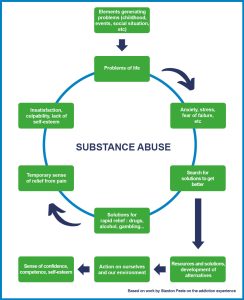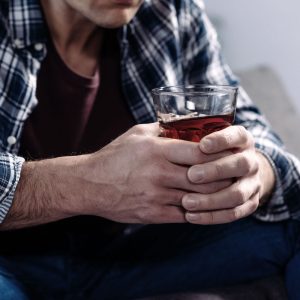Read also: Addiction and Reward Circuit
Are substances solely responsible for an addiction?
Let us take the example of the psychoactive substance most used in Québec: alcohol. The most recent survey of alcohol use in Québec revealed that in 2017-2018, 81% of Québécois, 12 and over, had drunk alcohol at least once during the year. Among those, 26% had abused alcohol at least once per month. It was also undisputed that drinking can indeed turn into an addiction. But if the substance is the only cause, why didn’t these 81% of Québécois all develop an addiction?
«Substance abuse is not the heart of the problem. It is a symptom of something else. »
«Addiction is not caused by a drug or its chemical properties. Addiction has to do with the effect a drug produces for a given person in given circumstances. » states Stanton Peele, a psychologist who theorized the experience of addiction in an article called The Addiction Experience published at the end of the 1970’s. In other words, an addiction develops not because the substance alone creates the addiction, but because this substance meets certain needs. For example, the need to alleviate certain suffering, to avoid problems. That means that «substance abuse is not the heart of the problem. It is a symptom of something else. » explains David Galipeau, Counselor on our addiction helplines, Drugs: Help and Referral and Gambling: Help and Referral.
Addiction is a cycle
In general, substances produce the effects we are looking for: suppressing emotions, forgetting problems…. but these effects are temporary. When they wear off, the problems are still there. Stanton Peele explains that substances have an effect of «relieving anxiety, which (paradoxically) decreases capability so that those things in life which cause anxiety grow more severe. » And as anxiogenic situations worsen, so does the temptation to escape from them. This is called the Addiction Cycle. This cycle is illustrated by the following diagram:

As illustrated in the diagram, once the cycle has been well-established, breaking it requires taking alternative actions to the usual solution of using. However, certain actions require time and effort, whereas substances, provide immediate comfort. «Substances make us feel certain emotions or block certain emotions we are tired of feeling. » explains Mr. Galipeau. «If it works immediately, why make an effort when we can just pick up a drink? It is the easy way out in dealing with certain situations, but the emotions do not disappear, they come back. If we ignore them, they built up. And when we do try to regain control, the effects of withdrawal are added on and can increase the symptoms of anxiety, depression, negative feelings and physical discomfort. It can get even more complex. »
The sense of security of substance use
While the addiction cycle makes facing life’s hardships harder, using becomes a sort of haven. Even if using substances can have negative and even destructive consequences on a person’s life, it remains that what s/he is searching for by using is «the predictability of the feeling, the assurance that s/he will always get the same effect. » explains Stanton Peele.
This feeling may be stronger for people who lack control in their lives or whose lives are controlled by their loved ones. Thus, by using, they find a haven as well as a feeling of control. It is in fact very common for addicts to ritualize their substance use.

- What s/he will drink.
- What time s/he will start drinking.
- The number of drinks needed to get the desired effect.
This routine is part of the safety aspect of using. David Galipeau explains: « There are people very comfortable within their routines. Before going to sleep, some have rituals such as turning off lights in a certain order, brushing their teeth, washing their face…and breaking that routine feels uncomfortable. It’s the same thing with addiction: if we are used to feeling an emotion and supressing it by using, it feels safe. You know the substance is there for you. »
Tolerance, withdrawal: when the fun is gone
« Using substances is kind of a cheat at happiness. » continues David Galipeau. « It disrupts the reward circuit. We may use because we know substances will give us a 10/10, whereas other activities will maybe give a 6/10 or 7/10 or sometimes even an 8/10. »
The problem is that when the substance gives us a 10/10, everything comes along with it: withdrawal, crash, guilt…. « We can temporarily reach 10/10, but quickly go back down to 2/10. And when we are at 2/10, we want to go back up to 10/10. So, we use again to get there. Go up to 10 then back to 2, then up to 10 and down to 2: it’s exhausting. »
«We get stuck in a vicious circle: we must use to feel better, but it no longer makes us feel better. And when it does make us feel better, we feel even worse after. »
The fun part is not only short lived, but the more we use, the more we get tolerant, and the desired effects are lessened. We must therefore learn to let go of those first times when using actually met our needs. Then, mourn our other interests that disappeared in favour of using. And face the consequences: If we have lost control, there are consequences, whether in terms of relationships, work, or even financial since using can be expensive. «We get stuck in a vicious circle: we must use to feel better, but it no longer makes us feel better. And when it does make us feel better, we feel even worse after. »
This circle is nicely illustrated in this short, animated film called Nuggets, released in 2014 with 22 million views on YouTube.
One of the main reasons it is hard to break this circle is that people are not aware of the resources that can help them. And, because society tends to view substance abuse as the problem and not a symptom. This way of thinking reinforces the stigmatization that some people go through out there, even from loved ones: «Stop using», «You know it’s bad for you», «You’re an addict». This way of always blaming the substance as being the heart of the problem is ineffective and even counter-productive and can push someone to seek refuge within substances even more. «We hear a lot of this kind of talk » states Mr. Galipeau. « Some people are even ridiculed for using substances. But the drugs, they will never judge them. They will be there when no one else is. That is what makes them even more valuable. »
Identifying the heart of the problem to break the cycle
When they begin a call, counselors at Drugs: Help and Referral quickly try to identify the needs hiding behind the drug, no matter the substance in question. In what circumstances does the person use? With friends? Alone? When does s/he use? From morning until night? During the week or weekend? Why does s/he use? To escape? Does her/his substance use have consequences on other areas of their lives? Did something trigger them to seek help?
«To treat an addiction, we must deal with the need hiding behind it. »
«To treat an addiction, we must deal with the need hiding behind it. » explains David Galipeau. «Imagine someone drinking to deal with loss: the person is unable to mourn and drinks to forget or deal with it. If the grieving isn’t dealt with, the drinking can remain. And if s/he gets control over her/his drinking, there is a risk of transferring that addiction onto another substance because the need behind it still hasn’t been dealt with. »
Another important aspect in counseling: accepting the person where they are at in their journey. In his definition of addiction, Stanton Peele explains that «addiction is a continuum», meaning it is a whole made up of different states, different degrees of intensity where we can move from one state to another.
Substance use can be divided into four broad categories:
- Medicinal/medical: for example, someone getting an opioid prescription for pain following an accident.
- Recreational: the same person, enjoying the effects of that medication, decides to take some during a rave.
- Problematic: s/he realises that s/he now needs this medication to have fun at raves. Her/his prescription is not renewed so s/he turns to the black market. Using becomes a regular thing.
- Addiction: s/he needs opioids to function.
«It’s not because we are in a certain category that we will stay there. People move up and down the continuum » continues Mr. Galipeau, confirming Mr. Steele’s words, for whom «it is rare that someone dedicates their whole life to an addiction, […] a person can be affected, according to the control this habit has over her/his life. »

We can help you
If you are concerned about your behaviour or that of someone close to you, you don’t have to face it alone: call us at 1-800-265-2626 or use the chat feature at the bottom of our site, on the right. Our counselors can provide you with support and help you establish strategies to regain control over your substance use or help someone you know. Our services are free, confidential and available 24 hours a day, 7 days a week.
Sources:
- Interview with David Galipeau Counselor on our addiction helplines, Drugs: Help and Referral and Gambling: Help and Referral
- The Addiction Experience, Stanton Peele, published in Addictions (Ontario Addiction Research Foundation), Summer-Fall, 1977, pp. 21-41 and 36-57
